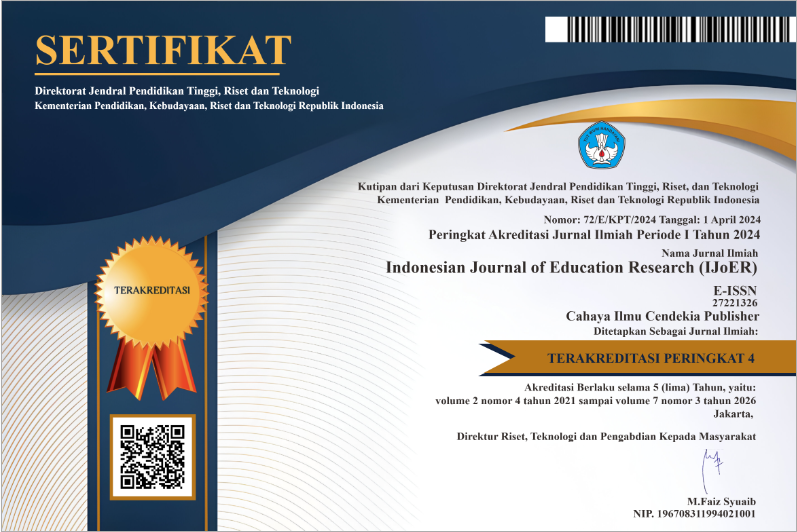Analysis of the Application of the Discovery Learning Model to Students' Creative Thinking Ability in Reaction Rate Material
Abstract
Purpose of the study: The purpose of this study was to describe and determine the relationship between the implementation of the discovery learning model in the matter of the rate of reaction with the students' creative thinking abilities.
Methodology: This research is a type of correlational descriptive research. The sampling technique used in this study is Simple Random Sampling. The instrument used in this research is the observation sheet. Data analysis techniques using normality and homogeneity tests. After the prerequisite test is carried out, the hypothesis test is then carried out.
Main Findings: The results of this research are that the application of the Discovery Learning model to reaction rate material can be carried out very well. This is because the teacher corrects errors in applying the model at the next meeting and there is a relationship between the application of the Discovery Learning model and students' creative thinking abilities in the reaction rate material in class XI in the medium category.
Novelty/Originality of this study: Provide information about the implementation of discovery learning learning models and their correlation with students' creative thinking abilities.
References
Kamid, K., Iriani, D., & Nawahdani, A. M., "Scientific Learning and Process Skills Mathematics: Comparison and Relationship," JPI (Jurnal Pendidikan Indonesia), vol. 11, no. 2, pp. 228-239, 2022, https://doi.org/10.23887/jpiundiksha.v11i2.37158
M. A. Umar, “Penerapan pendekattan saintifik dengan meode pembelajaran berbasis proyek (Project-Based Learning) dalam materi ekologi,” Bionatural J. Ilm. Pendidik. Biol., vol. 4, no. 2, pp. 1–12, 2017, [Online]. Available: https://www.ejournal.stkipbbm.ac.id/index.php/bio/article/view/194
A. W. Kurniasih, “Scaffolding sebagai Alternatif Upaya Meningkatkan Kemampuan Berpikir Kritis Matematika,” Kreano, J. Mat. Kreat., vol. 3, no. 2, pp. 113–124, 2012.
S. Nurjan, “Pengembangan Berpikir Kreatif,” AL-ASASIYYA J. Basic Educ., vol. 3, no. 1, pp. 105–116, 2018.
M. Mahmudah, “Pengelolaan Kelas: Upaya Mengukur Keberhasilan Proses Pembelajaran,” J. Kependidikan, vol. 6, no. 1, pp. 53–70, 2018, doi: 10.24090/jk.v6i1.1696.
K. Abdillah and T. Hamami, “Pengembangan Kurikulum Menghadapi Tuntutan Kompetensi Abad Ke 21 Di Indonesia,” J. Pendidik. Islam Al-Ilmi, vol. 4, no. 1, pp. 1–20, 2021, doi: 10.32529/al-ilmi.v4i1.895.
Sudirman, “Peran Guru Sebagai Pembelajar dalam Memotivasi Peserta Didik Usia SD,” Pros. Disk. Panel Pendidik., no. April, pp. 60–76, 2017.
D. Rostika, “Penerapan Model Pembelajaran Kooperatif Tipe Script,” J. Educ. Dev., vol. 1, no. 2, pp. 240–251, 2020, doi: 10.5281/zenodo.4004041.
I. S. Wardhani, “Menumbuhkan Tindak Pikir Kreatif Melalui Model Pembelajaran Pace,” JP2M (Jurnal Pendidik. dan Pembelajaran Mat., vol. 1, no. 2, p. 31, 2020, doi: 10.29100/jp2m.v1i2.192.
F. Istiqomah, A. Widiyatmoko, and I. U. Wusqo, “Pengaruh Media Kokami Terhadap Keterampilan Berpikir Kreatif dan Aktivitas Belajar Tema Bahan Kimia,” Unnes Sci. Educ. J., vol. 5, no. 2, p. 1220, 2016, [Online]. Available: http://journal.unnes.ac.id/sju/index.php/usej
N. M. Rosa and A. Pujiati, “Pengaruh Model Pembelajaran Berbasis Masalah Terhadap Kemampuan Berpikir Kritis dan Kemampuan Berpikir Kreatif,” Form. J. Ilm. Pendidik. MIPA, vol. 6, no. 3, pp. 175–183, 2017, doi: 10.30998/formatif.v6i3.990.
S. W. Al-Idrus, Muti’ah, and R. Rahmawati, “Pengembangan Kemampuan Berpikir Kreatif Mahasiswa melalui pembelajaran berbasis proyek pada mata kuliah kimia lingkungan di masa pandemic covid 19,” As-Sabiqun J. Pendidik. Islam Anak Usia Dini, vol. 3, no. 1, pp. 14–25, 2021, doi: 10.1080/17518253.2019.1609602.
Copyright (c) 2023 Niski Nadila, Louis-Charl Cloete Coetzee, Beatrice Arwenyo

This work is licensed under a Creative Commons Attribution-NonCommercial 4.0 International License.
Authors who publish with this journal agree to the following terms:
- Authors retain copyright and acknowledge that the Indonesian Journal of Education Research (IJoER) is the first publisher licensed under a Creative Commons Attribution 4.0 International License.
- Authors are able to enter into separate, additional contractual arrangements for the non-exclusive distribution of the journal's published version of the work (e.g., post it to an institutional repository or publish it in a book), with an acknowledgment of its initial publication in this journal.
- Authors are permitted and encouraged to post their work online (e.g., in institutional repositories or on their website) prior to and during the submission process, as it can lead to productive exchanges and earlier and greater citation of published work.






.png)
.png)




















